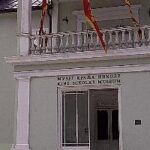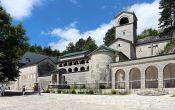August 2, 2013
More on Montenegro
If I’ve given the impression that most of the cities we’ve seen have been walled fortresses that go back to the middle ages in cities settled by Dalmatians, Greeks, Romans, maybe Byzantines, and Venetians or
Turks, that’s not far from the truth. My son David suggested that I was taking pictures in one city and giving them different names. That may be why today’s visits were significantly different, broadening my understanding of the Balkans.

 We went into the interior of Montenegro, to the capital (1878-1918) of the Kingdom of Montenegro, Cetinje. As it turned out, the trip involved climbing up 3,000 feet from Buka Bay near Kotor for an incredible look at one of UNESCO’s designated “most beautiful bays in the world.” The road built in the 1880s has 25 hairpin turns, and overlooks the 20 some mile long bay, which has four branches—and you can see them all. About half way up, we reached an old fort that marked the border between Austria and the Ottoman Empire/Montenegro. As I realized yesterday while writing my blog, Kotor could not have been part of the Montenegrin Kingdom because it was Venetian, then Austrian, and did not join Yugoslavia until after World War I.
We went into the interior of Montenegro, to the capital (1878-1918) of the Kingdom of Montenegro, Cetinje. As it turned out, the trip involved climbing up 3,000 feet from Buka Bay near Kotor for an incredible look at one of UNESCO’s designated “most beautiful bays in the world.” The road built in the 1880s has 25 hairpin turns, and overlooks the 20 some mile long bay, which has four branches—and you can see them all. About half way up, we reached an old fort that marked the border between Austria and the Ottoman Empire/Montenegro. As I realized yesterday while writing my blog, Kotor could not have been part of the Montenegrin Kingdom because it was Venetian, then Austrian, and did not join Yugoslavia until after World War I.
The ride to Cetinje took us through the Montenegrin countryside, and the towns went from Kotor and its surrounding (mostly Catholic) towns to an area that had come under Greek/Byzantine or Turkish occupation. We went through one town, known for its prosciutto ham and cheese and wine—and for providing the dynasty that successfully overthrew the Turks in Montenegro. The struggle, our guide said, went on for nearly 500 years, as the Christian Montenegrins resisted becoming Muslim. The founder of
the dynasty was a priest from that town, who became a prince bishop; in 1878, by then headed by a prince, Montenegro had the European powers guarantee the independence of the Principality of Montenegro, with its capital in Cetinje.
 We visited the palace of Nicholas I, the only “king” of Montenegro, who in 1910 had himself crowned. His family, however, had made major contributions to the royal families of Europe because he had 9 daughters, 6 of whom married royalty—including the wife of Victor Emmanuel, first king of the unified Italy; several Romanovs in Russia; and the wife of the king of Serbia. The family fled Montenegro in 1916 when Austria occupied the country, expecting to return after the end of the First World War. Instead, the Serbian king became the ruling family in the new Yugoslavia, and King Nikolas and his family was banned from returning.
We visited the palace of Nicholas I, the only “king” of Montenegro, who in 1910 had himself crowned. His family, however, had made major contributions to the royal families of Europe because he had 9 daughters, 6 of whom married royalty—including the wife of Victor Emmanuel, first king of the unified Italy; several Romanovs in Russia; and the wife of the king of Serbia. The family fled Montenegro in 1916 when Austria occupied the country, expecting to return after the end of the First World War. Instead, the Serbian king became the ruling family in the new Yugoslavia, and King Nikolas and his family was banned from returning.
Today’s new country, independent, has invited the great grandson to return, and has reburied the only king and his wife in the country. I think I’ve gotten that part of Montenegro history straightened out finally. Cetinje  had 17 embassy buildings, several of which still remain (though the capital has moved to another city), with an American ambassador living in a local hotel. The “palace” resembled to me the contemporary Turkish palace, but the scale was Montenegro, not the Ottomans. Small, but tasteful, the palace had a billiard table hauled up a dirt path by bearers (up and over 3000 feet) to provide entertainment in what must have been a rather backwater diplomatic assignment.
had 17 embassy buildings, several of which still remain (though the capital has moved to another city), with an American ambassador living in a local hotel. The “palace” resembled to me the contemporary Turkish palace, but the scale was Montenegro, not the Ottomans. Small, but tasteful, the palace had a billiard table hauled up a dirt path by bearers (up and over 3000 feet) to provide entertainment in what must have been a rather backwater diplomatic assignment.
 The other building I barely had time to see was a monastery. I think it was Orthodox, because, apart from the coast, Montenegro embraced the Orthodox church, and indeed, that affiliation, born from its Byzantine/Greek heritage, in the 19th century made it an ally of Russia, whose support for Orthodoxy and Slavs was a lynchpin of its foreign policy. The monastery was being visited by a large group who had it closed until they were done, which was unfortunate for me because our time was limited. I was told it was a special saint’s day—John the Baptist—and the monastery had a relic of the Saint—from his arm.
The other building I barely had time to see was a monastery. I think it was Orthodox, because, apart from the coast, Montenegro embraced the Orthodox church, and indeed, that affiliation, born from its Byzantine/Greek heritage, in the 19th century made it an ally of Russia, whose support for Orthodoxy and Slavs was a lynchpin of its foreign policy. The monastery was being visited by a large group who had it closed until they were done, which was unfortunate for me because our time was limited. I was told it was a special saint’s day—John the Baptist—and the monastery had a relic of the Saint—from his arm.
The trip back took a more direct route that went past the Adriatic coast (where we are cruising right now on our way to Albania—as someone remarked at the table tonight, “I never thought I would visit Albania!” I share the sentiment.) In the summer, it is Montenegro’s chief attraction, with 117 beaches.
The town of Budva, not far from Kotor, has attracted a multimillion dollar investment from Canadians to develop a major yacht port, and there were many other major resorts and condos being built. One is a former monastery which has been taken over by a company (Aman?) that specializes in upscale resorts in such places as Bali. The St. Stefan resort, they told us, charges 800-1000 Euro a night—roughly $1200. Glad we’re not staying there!